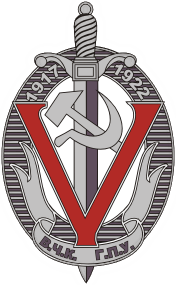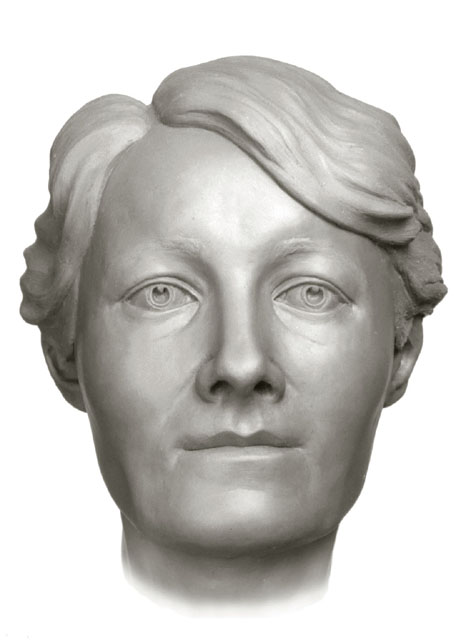|
Stepan Vaganov
Stepan Vaganov ( Russian: Степан Ваганов; 1886–1918) was a Russian sailor and Bolshevik revolutionary. A participant in the establishment of Soviet power in the Urals and in the civil war, he is known for his personal participation in the killing of the Romanov family under Yakov Yurovsky on 17 July 1918. Biography Early life and military service Stepan Vaganov was born in 1886 near the Verkh-Isetsky Metallurgical Plant, in a working-class family. He was brought up in an Orthodox family and finished education at the parish school and got a job as a locksmith. In 1907, Vaganov was married to a resident of his village, Olga Ivanovna. The wedding took place in the Church of the Nativity of Christ of the same faith. After the wedding, the young couple lived in the parental home of the Vaganovs, where they had seven children in seven years. In 1910 he was called up for military service, graduated from the Mineman School for lower ranks in Kronstadt, and served o ... [...More Info...] [...Related Items...] OR: [Wikipedia] [Google] [Baidu] |
Yekaterinburgsky Uyezd
Yekaterinburgsky Uyezd (''Екатеринбургский уезд'') was one of the subdivisions of the Perm Governorate of the Russian Empire. It was situated in the southeastern part of the governorate. Its administrative centre was Yekaterinburg. Demographics At the time of the Russian Empire Census of 1897, Yekaterinburgsky Uyezd had a population of 412,296. Of these, 96.6% spoke Russian, 2.1% Bashkir, 1.0% Tatar, 0.1% German, 0.1% Polish and 0.1% Yiddish Yiddish (, or , ''yidish'' or ''idish'', , ; , ''Yidish-Taytsh'', ) is a West Germanic language historically spoken by Ashkenazi Jews. It originated during the 9th century in Central Europe, providing the nascent Ashkenazi community with a ver ... as their native language. References Uezds of Perm Governorate {{Russia-gov-stub ... [...More Info...] [...Related Items...] OR: [Wikipedia] [Google] [Baidu] |
Russian Cruiser Asia
''Asia'' (Russian: ''А́зия'') was a cruiser A cruiser is a type of warship. Modern cruisers are generally the largest ships in a fleet after aircraft carriers and amphibious assault ships, and can usually perform several roles. The term "cruiser", which has been in use for several hu ... of the Imperial Russian Navy. The ship was originally the Philadelphia-built iron merchant steamship ''Columbus'' completed in 1874 The iron passenger-cargo steamship ''Columbus'' was built 1873/74 in Philadelphia by William Cramp & Sons as Yard No.184 for local shipowner William P Clyde & Co. ''Columbus'' was bought by Russia in May 1878, one of three merchant ships purchased in the United States to be transformed into naval cruisers: ''State of California'' became ''Europa'', ''Saratoga'' became ''Afrika'', and ''Columbus'' became ''Asia''. After initial conversion by her builders, Cramp, in Philadelphia, she was sailed to Russia by a Russian crew for further outfitting in Kro ... [...More Info...] [...Related Items...] OR: [Wikipedia] [Google] [Baidu] |
Necrophilia
Necrophilia, also known as necrophilism, necrolagnia, necrocoitus, necrochlesis, and thanatophilia, is sexual attraction towards or a sexual act involving corpses. It is classified as a paraphilia by the World Health Organization (WHO) in its ''International Classification of Diseases'' ( ICD) diagnostic manual, as well as by the American Psychiatric Association in its ''Diagnostic and Statistical Manual'' (DSM). Origins of term Various terms for the crime of corpse-violation animate sixteenth- through nineteenth-century works on law and legal medicine. The plural term "nécrophiles" was coined by Belgian physician Joseph Guislain in his lecture series, ''Leçons Orales Sur Les Phrénopathies,'' given around 1850, about the contemporary necrophiliac François Bertrand: Psychiatrist Bénédict Morel popularised the term about a decade later when discussing Bertrand. History In the ancient world, sailors returning corpses to their home country were often accused of necrophilia ... [...More Info...] [...Related Items...] OR: [Wikipedia] [Google] [Baidu] |
Mikhail Medvedev-Kudrin
Mikhail Aleksandrovich Medvedev (Kudrin) (September 30, 1891 – January 13, 1964) was a Russian revolutionary, Chekist, direct participant in the execution of the last Russian Emperor Nicholas II, his family, and close associates in the Ipatiev House in Yekaterinburg on the night of July 17, 1918. Biography Mikhail Kudrin was born in the village of Dedyukhino in the Sarapul District, into a Russian peasant family. In 1900 he graduated from the parish school in the village of Izgar, and from 1900 to 1908 he lived in Chistopol, where he began to study at the school of artisan students, but after the second grade he was forced to leave school due to the difficult financial situation of the family. In 1908, Kudrin moved to Perm, where he worked at a power plant, then as a locksmith at an oil warehouse, and finally as an oiler on a tugboat. In September 1911, he left for Baku, where he got a job in the engine crew of a tanker in the Caspian Sea and joined the "Union of Non-Indu ... [...More Info...] [...Related Items...] OR: [Wikipedia] [Google] [Baidu] |
Anna Demidova
Anna Stepanovna Demidova (26 January 1878 – 17 July 1918) was a lady-in-waiting in the service of Empress Alexandra of Russia. She stayed with the Romanov family when they were arrested, and was executed together with Alexandra and the Romanov family on 17 July 1918. She had shared the Romanov family's exile at Tobolsk and Ekaterinburg following the Russian Revolution of 1917 before their execution. She is remembered for staying with the Romanovs to the end. In 1981 she was canonized as an Orthodox martyr by the Russian Orthodox Church Outside Russia (ROCOR) but not by the Russian Orthodox Church. Life Anna Demidova, whose nickname was "''Nyuta''," was described in adulthood as a "tall, statuesque blonde."King, Greg, and Wilson, Penny, ''The Fate of the Romanovs,'' John Wiley and Sons, Inc., 2003, , pp. 63–64 She was the daughter of Stepan Demidov and his wife. Her father was a well-off merchant in Cherepovets, where he also served on the Cherepovets City Duma, and was a ... [...More Info...] [...Related Items...] OR: [Wikipedia] [Google] [Baidu] |
Grand Duchess Tatiana Nikolaevna Of Russia
Grand Duchess Tatiana Nikolaevna of Russia (Tatiana Nikolaevna Romanova; ; – 17 July 1918) was the second daughter of Tsar Nicholas II, the last monarch of Russia, and of Tsarina Alexandra. She was born at Peterhof Palace, near Saint Petersburg. Tatiana was the younger sister of Grand Duchess Olga and the elder sister of Grand Duchess Maria, Grand Duchess Anastasia, and Tsarevich Alexei. She was considered to be the most beautiful of all her sisters and the most aristocratic in appearance. She was known amongst her siblings as "the governess" for her domineering but also maternal ways. Tatiana was the closest of all the children to her mother ( Tsarina Alexandra), often spending many hours reading to her. During World War I, she chaired many charitable committees and (along with her older sister, Grand Duchess Olga) trained to become a nurse. She tended to wounded soldiers on the grounds of Tsarskoye Selo from 1914 to 1917. Her time as a nurse came to an end with her ... [...More Info...] [...Related Items...] OR: [Wikipedia] [Google] [Baidu] |
Grand Duchess Olga Nikolaevna Of Russia
Grand may refer to: People with the name * Grand (surname) * Grand L. Bush (born 1955), American actor * Grand Mixer DXT, American turntablist * Grand Puba (born 1966), American rapper Places * Grand, Oklahoma * Grand, Vosges, village and commune in France with Gallo-Roman amphitheatre * Grand Concourse (other), several places * Grand County (other), several places * Grand Geyser, Upper Geyser Basin of Yellowstone * Grand Rounds National Scenic Byway, a parkway system in Minneapolis, Minnesota, United States * Le Grand, California, census-designated place * Grand Staircase, a place in the US. Arts, entertainment, and media * ''Grand'' (Erin McKeown album), 2003 * ''Grand'' (Matt and Kim album), 2009 * ''Grand'' (magazine), a lifestyle magazine related to related to grandparents * ''Grand'' (TV series), American sitcom, 1990 * Grand piano, musical instrument * Grand Production, Serbian record label company * The Grand Tour, a new British automobile ... [...More Info...] [...Related Items...] OR: [Wikipedia] [Google] [Baidu] |
Ipatiev House
Ipatiev House (russian: Дом Ипатьева) was a merchant's house in Yekaterinburg (later renamed Sverdlovsk in 1924, renamed back to Yekaterinburg in 1991) where the former Emperor Nicholas II of Russia (1868–1918, reigned 1894–1917), his family, and members of his household were executed in July 1918 following the Bolshevik Revolution. Its name is identical to that of the Ipatiev Monastery in Kostroma, from where the Romanovs came to the throne. As an act for the 60th anniversary of the Russian Revolutions, it was demolished in 1977 by orders of the Politburo to the local soviet government, almost 59 years after the Romanov family murder and 14 years before the dissolution of the Soviet Union itself. History In the 1880s, Ivan Redikortsev, an official involved in the mining industry, commissioned a two-story house to be built on the slope of a prominent hill. The length of the facade was 31 metres. In 1898, the mansion passed to Sharaviev, a gold dealer of tainted ... [...More Info...] [...Related Items...] OR: [Wikipedia] [Google] [Baidu] |
Filipp Goloshchekin
Filipp Isayevich Goloshchyokin (russian: Филипп Исаевич Голощёкин) (born Shaya Itsikovich) (russian: Шая Ицикович) ( – October 28, 1941) was a Bolshevik revolutionary, Soviet politician, and party functionary, principally remembered for his collectivization in the Kazakh Autonomous Socialist Soviet Republic which subsequently caused the Kazakh famine of 1932–1933, in which 1.5 million people died, of whom 1.3 million were ethnic Kazakhs. An estimated 38 to 42 percent of all Kazakhs died, the highest percentage of any ethnic group killed by the Soviet famine of 1932–1933. Other sources state that as many as 2.0 to 2.3 million died. A member of the Russian Social Democratic Labour Party since 1903 and a founding member of the Russian Communist Party (Bolsheviks), he was a participant in the Revolution of 1905 and the October Revolution. During the Russian Civil War he was a major figure in the establishment of Soviet power in the ... [...More Info...] [...Related Items...] OR: [Wikipedia] [Google] [Baidu] |
Peter Ermakov
Pyotr Zakharovich Ermakov (; – 22 May 1952) was a Russian Bolshevik revolutionary, notable as one of several men responsible for the execution of the Romanov family, including the deposed Tsar Nicholas II, his wife, their children, and their retinue. Biography Pyotr Zakharovich Ermakov was born on , in to the family of a Russian factory worker and raised in and around the Verkh-Isetskiy workhouse in Yekaterinburg, Russian Empire. Ermakov graduated from the local parish school, working thereafter as a metal craftsman, and between 1909 and 1912, is listed as living in Vologodskaya Province. In January 1906, Ermakov became a member of the Russian Social Democratic Labour Party and became head of the illegal combat organisation of the RSDLP in the Verkh-Isetskiy. Soon, Ermakov became a member of the underground Yekaterinburg Committee of the RSDLP, which transferred him to an illegal position. Ermakov was assigned the role of one of the leaders of the militants, whose main t ... [...More Info...] [...Related Items...] OR: [Wikipedia] [Google] [Baidu] |
Red Guards (Russia)
, war=The Russian Revolution of 1917 and Russian Civil War , image= , caption= Red flags were used by guards in several modifications and variations , active=1917–1918(became core units of the Red Army) , ideology=Communism , position=Far-left , leaders=RSDLP(b) and Soviets , clans= , headquarters=Every major city , area=Russian Soviet Federative Socialist Republic and Russian Republic , size= , partof=Red Army (since January 1918) , predecessor= , allies= several communist states , opponents= Russian Provisional Government White MovementEntente Pro-independence movements in Russian Civil War , battles=October RevolutionRussian Civil War Red Guards (russian: Красная гвардия) were paramilitary volunteer formations consisting mainly of factory workers, peasants, cossacks and partially of soldiers and sailors for "protection of the soviet power". Red Guards were a transitional military force of the collapsing Imperial Russian Army and the base formations of Bols ... [...More Info...] [...Related Items...] OR: [Wikipedia] [Google] [Baidu] |





